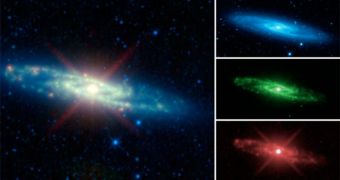Using the NASA WISE telescope, a team of experts was able to obtain new and amazing views of the relatively near-by Sculptor Galaxy, which is also known under the astronomical designation NGC 253.
This composite view of the galaxy shows it in different types of hues, each of which is obtained by one of the four infrared detectors aboard the Wide-field Infrared Survey Explorer (WISE).
The main image of the four was collected using all four detectors at the same time, researchers at the NASA Jet Propulsion Laboratory (JPL) explain.
The active side of the galaxy is revealed in the bottom right image depicted in red. It shows new stars being born from massive molecular clouds, and reveals that this process is taking place especially at the core of the galaxy.
In order to be able to penetrate through the massive dust clouds surrounding the area, scientists used the longest-wavelength detector on WISE, which is capable of snapping images at 22 microns.
According to the team behind the new observations, observing Sculptor with this detector was one of the few instances in which diffraction spikes were noticed.
Generally, there are considered to be telescope artifacts, which appear when very intense light reaches the detectors. Astronomers usually had seen them when they point optical telescopes at really bright stars.
The green-coded image was taken by a WISE detector that functions at a wavelength of 12 microns, and was used to detect emerging stars in NGC 235.
Researchers found the blue stars concentrated n specific areas around the galactic core, and also in the galaxy's spiral arms. Sculptor is probably powered by a very large black hole as well.
Counter-intuitively, these stars glow in infrared because they release ultraviolet radiation. This light is absorbed by dust and soot particles in the stars' vicinity, which then re-release it as IR light.
According to experts, the blue-coded image is used to show stars of all ages that exist in NGC 235, and can be found throughout the galaxy. These stars exhibit no preference for certain areas.
The photo was taken by using the two shortest-wavelength detectors on the NASA telescope. They take measurements at wavelengths of 3.4 and 4.6 microns, respectively.
Sculptor is located in the constellation with the same name, and astronomers estimate that it lies some 10.5 million light-years away from Earth. This is a short distance by cosmical standards.
The formation was discovered by astronomer Caroline Herschel back in 1783. She was the sister of Sir William Herschel, the renowned scientist who discovered infrared light.
The European Space Agency's (ESA) Herschel Space Observatory is named after the scientist.

 14 DAY TRIAL //
14 DAY TRIAL //